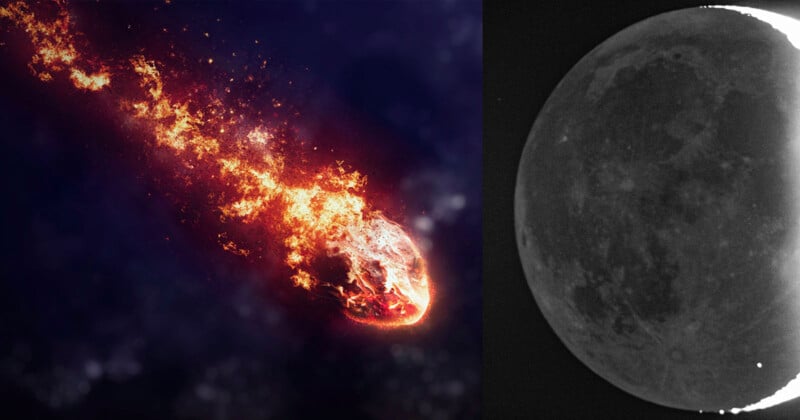Astronomer Captures Meteorite Crashing into the Moon

A Japanese astronomer captured the moment a meteorite crashed into the Moon creating a flash of light and a new crater.
Daichi Fujii, director of the Hiratsuka City Museum, records the Moon from his home south of Tokyo and witnessed the impact on February 23.
“I was able to catch the biggest lunar impact flash in my observation history,” Fujii writes on Twitter. “It was a huge flash that continued to shine for more than one second.”
私の観測史上最大の月面衝突閃光を捉えることができました!2023年2月23日20時14分30.8秒に出現した月面衝突閃光を、平塚の自宅から撮影した様子です(実際の速度で再生)。なんと1秒以上も光り続ける巨大閃光でした。月は大気がないため流星や火球は見られず、クレーターができる瞬間に光ります。 pic.twitter.com/Bi2JhQa9Q0
— 藤井大地 (@dfuji1) February 24, 2023
The meteorite is believed to have struck near the Ideler L crater, slightly northwest of the Pitiscus crater, Fujii says.
The astronomer hopes that the new crater made by the meteoroid’s impact will be imaged by NASA’s Lunar Reconnaissance Orbiter or India’s Chandrayaan 2 lunar probe.
Fujii posted the videos and stills to his Twitter page where he regularly watches the skies for celestial events such as fireballs burning up in Earth’s atmosphere.
The video, played in real-time, shows a spec of white light burning brightly on the lunar surface before quickly disappearing again.
“From the way it shines, it is highly likely that it is a lunar impact flash,” adds Fujii.
Why do Meteorites Impact the Moon?
Meteoroids collide with Earth every day, but the vast majority of them burn up as they enter the planet’s atmosphere.
However, the Moon does not have that type of significant atmosphere meaning that meteors that would burn up above Earth can strike the lunar surface in large explosions.
As noted by Space, meteors travel at an average speed of 8.3 miles per second (13.4 kilometers per second), or 30,000 miles per hour (48,280 kilometers per hour).
When a meteor traveling at those speeds hits the Moon it generates intense heat and incinerates the surface making a crater. It also creates a flash of light which if large enough and occurs during the lunar nighttime can be seen from Earth.
In 2019, during the super blood wolf moon total lunar eclipse, cameras captured a meteorite slamming into the shadow-covered moon.
Image credits: Moon images courtesy of Daichi Fujii.
Image credits: Header photo partly licensed via Depositphotos.